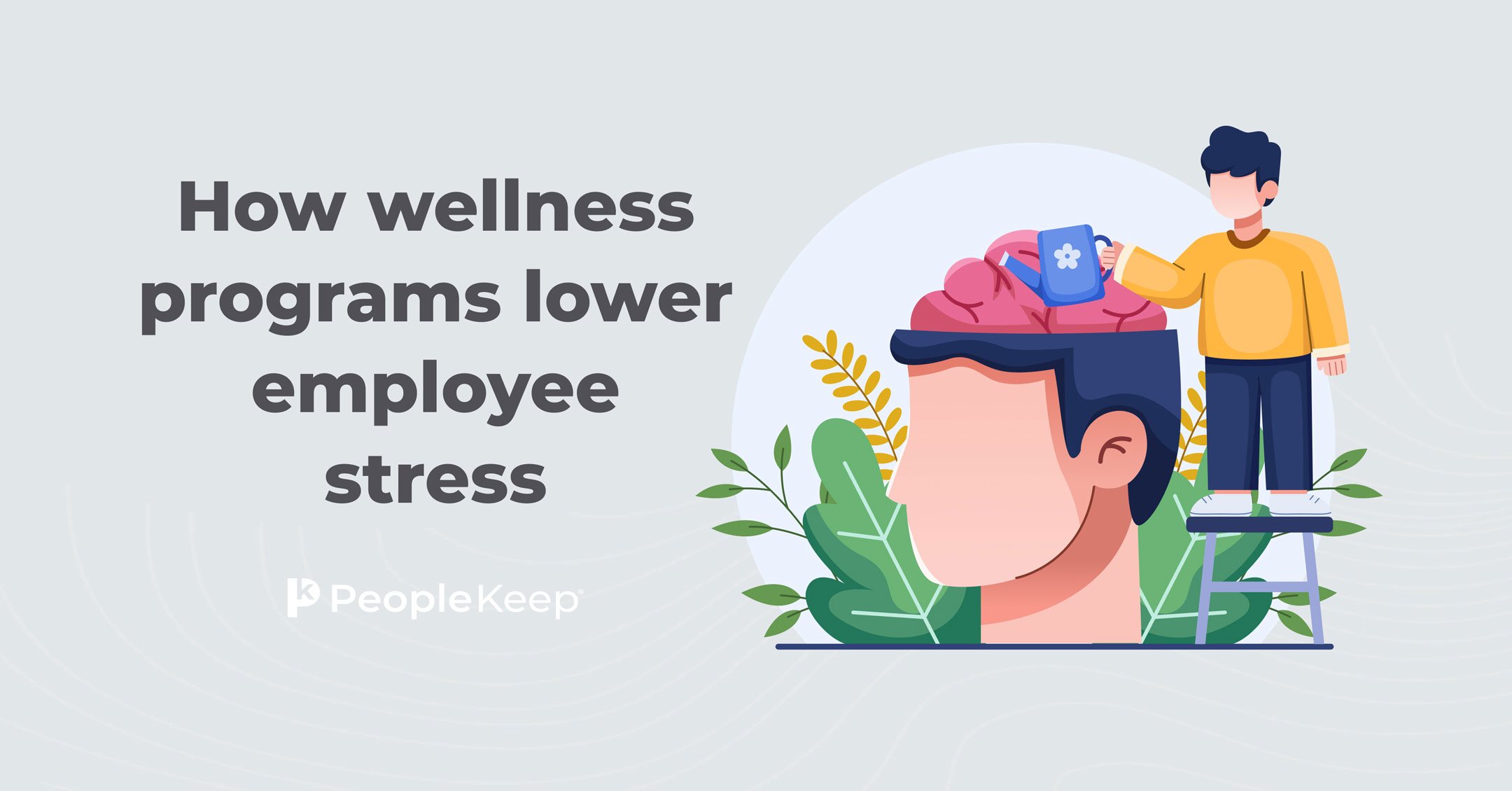How to improve employee retention with a workplace wellness program
By Holly Bengfort on January 28, 2025 at 8:15 AM
Are you struggling with high employee turnover? While many businesses focus on recruitment, creating a positive work environment for existing employees is equally important.
In an era when job-hopping has become the norm, companies need to find innovative ways to stand out and hold onto their employees. One effective strategy that's gaining traction across industries is the implementation of comprehensive workplace wellness programs. These initiatives promote physical health and significantly enhance employee morale and employee satisfaction.
In this article, we'll explore how wellness programs and benefits can improve employee retention at your organization.
In this blog post, you'll learn the following:
- What makes an effective employee wellness program.
- Employee wellness program ideas.
- Options for affordable health and wellness benefits.
What are wellness programs?
Effective wellness programs help promote healthy lifestyles and a healthy work-life balance. Employers provide them to employees to help them avoid illness and stress while improving their overall well-being.
There are many different wellness programs. Some focus more on physical fitness while others focus on mental health. Employers usually sponsor them, but some health insurance plans or payroll services also offer them to organizations.
How do wellness programs improve employee retention?
Organizations need to provide employee benefits and other perks to attract and retain their best workers. Otherwise, your employees will go elsewhere.
One of the best ways to keep your employees is to offer wellness benefits. Employee well-being is essential to any organization because it directly affects productivity, engagement, and job satisfaction.
Employees increasingly seek health and wellness benefits from their employers. PeopleKeep's 2024 Employee Benefits Survey found that 92% of employees consider health benefits important. Another 80% value mental health and/or wellness benefits.
A wellness program can improve your employees' overall health and mood, reducing how often they're out sick. These programs can also encourage employees to do more for their health at home, which helps reduce health risks and healthcare costs. Wellness can also be expensive for employees. By helping them with gym memberships or other wellness perks, you can help reduce employees’ financial stress.
Improving employee well-being increases productivity at work. Employees who feel good about their workplace are more likely to stay engaged. They’re also more likely to recommend their organizations to others through referrals. According to MetLife's 22nd Annual U.S. Employee Benefit Trends Study1, employees who feel cared for are 60% more likely to stay at their organization.
What are some examples of employee wellness programs?
There are many types of wellness programs available. To meet your organization's needs, they can be as simple or complex as you'd like.
Examples of standard programs include:
- Smoking cessation programs
- Employee health screenings
- Biometric screening programs
- Nutrition education classes
- Vaccination clinics
- Weight loss programs
- Stress management programs
These are all examples of employee wellness activities with one goal in mind. However, your ideal program should include a holistic approach to employee well-being.
KFF's 2024 Employer Health Benefits Survey2 found that among companies providing health benefits:
- 40% of small businesses and 69% of large businesses have programs to assist employees in quitting cigarette smoking or using tobacco.
- 34% of small companies and 62% of large companies offer wellness initiatives aimed at weight loss.
- 33% of small businesses and 70% of large businesses provide other forms of lifestyle or behavioral coaching programs.
- 54% of small companies and 79% of large companies that offer health benefits provide at least one of these three types of programs.
What should your employee wellness program include?
Healthy habits extend beyond physical wellness and food choices. For that reason, you'll want to go the extra mile with your commitment to employee health.
To achieve holistic employee wellness, you'll need to design a wellness program that touches on all facets of wellness, including:
- Physical health
- Mental health
- Financial health
- Social well-being
Designing your wellness program around these pillars ensures that it supports and includes all of your employees.
In-office employee wellness benefits
When employee perks first emerged, only large corporations, particularly tech giants, offered them as part of a corporate wellness program. Now, you can find these in-office perks at small and medium-sized businesses across the country.
Popular in-office employee wellness benefits include:
- Promoting or offering healthy food options
- Extended lunch breaks
- Providing opportunities for physical activity in the workplace
- Providing opportunities for employees to connect through events and activities
- Creating an employee recognition program
- Ensuring that everyone has access to mental health resources
With any wellness program, you'll also want to make time for in-office activities anyone can participate in.
Some in-office ideas for employees are:
- Taking a group walk
- Taking group yoga classes
- Engaging in friendly competitions for step challenges, sleep challenges, or dance-off challenges
- Planning cultural awareness events
- Playing games and quizzes
- Creating a book club
- Hosting birthday celebrations
- Reduce workplace stress by having days without meetings (this gives employees time to focus on other projects and tasks)
- Taking company retreats (they don't have to be far from the office)
You can also schedule events around mental health, such as a group meditation session. All of these wellness activities can have a positive impact on your employees. Team-building activities help them bond and feel more relaxed at work.
Remote employee wellness benefits
With many organizations offering remote work options, creating a wellness program is more challenging than ever. Remote employees won't benefit from your in-office benefits and programs. So, how do you create a wellness program with these employees in mind?
You can modify in-office employee wellness efforts to fit a virtual work environment. This includes hosting virtual activities to help your employees feel connected. You can also provide care packages to your remote employees, such as healthy snacks or lunch once a month through a delivery service. Offering health and wellness benefits is another great way to improve your remote workers' physical and emotional well-being.
To be successful, these programs must adapt to each employee's needs. You can do this by offering your employees personalized benefits.
Offering personalized wellness benefits
Offering personalized wellness benefits is one of the best ways to ensure that all employees can participate in your wellness program.
Personalized benefits allow your employees to choose how to use their benefits. With personalized wellness benefits, you can provide your employees with a monthly allowance for expense reimbursement or an expense card.
Various personalized wellness benefits are available for organizations of all sizes. We'll break down a few of the most common ones below.
Health benefits
Supporting your employees' physical and mental health is one of the core pillars of any wellness program.
There are various personalized health benefits available, including:
- Health reimbursement arrangements (HRAs)
- Health savings accounts (HSAs)
- Flexible spending accounts (FSAs)
- Health stipends
HRAs are a great option for businesses that want to offer an individualized benefit while saving money and time compared to a group health plan. Employers reimburse their employees for healthcare expenses such as individual health insurance premiums and qualifying out-of-pocket medical expenses. HRAs are tax-free for both the employer and the employee.
Some HRA-eligible expenses for employee health and wellness:
- Monthly premiums for health, vision, and dental plans
- Preventive care
- Acupuncture
- Alternative dietary supplements
- Alternative healers
- Chiropractic care
- Dietitian/nutrition services
- Herbal or homeopathic medicines
- Mental health counseling
* Some holistic health services require a doctor’s note to prove they’re medically necessary.
If your organization has 50 or more full-time equivalent employees, the Affordable Care Act (ACA) requires you to offer health benefits to at least 95% of your full-time employees. An individual coverage HRA (ICHRA) is a great alternative to group health insurance for organizations that need to satisfy the employer mandate.
You could also offer your employees a taxable health stipend. Health stipends allow you to give your employees money for medical costs. This makes health stipends an excellent option for organizations with employees who receive advance premium tax credits, as those employees can use their health stipend benefit without affecting their APTC eligibility. However, a stipend doesn't satisfy the Affordable Care Act's employer mandate. You also can't require proof of purchase for health insurance or any items in IRS Publication 502.
Wellness stipends
A wellness stipend allows organizations to give their employees an allowance for a wide variety of wellness expenses. Instead of focusing on on-site wellness perks for your office, you can give your employees the freedom to choose how they want to use their wellness stipend.
Employees can use their wellness stipends on a wide range of products and services, such as:
- Gym memberships
- Fitness classes
- Dance classes
- Massage therapists
- Wearable fitness trackers
- Home exercise equipment
- Healthy lunches
- Personal trainers
- Financial wellness services
- Mental health services
Wellness stipends are taxable, meaning you'll need to report this extra income on your employees' W-2s. However, offering a wellness stipend is an easy way to ensure that you include all of your employees in a wellness program that works best for their individual needs.
How to boost employee participation in wellness programs
Worksite wellness programs can increase employee retention and promote a healthier working atmosphere if most employees are actively involved.
Organizations can do their part to encourage active participation by doing the following:
- Don't strive for perfection. Plan for challenges and even the occasional failure with your wellness program. Set up a support structure to manage any obstacles.
- Provide incentives for participation. An easy way to improve participation rates is by reimbursing employee wellness expenses.
- Take a team approach. Improving employee health is hard work. Allow your workers to achieve goals with the help and support of their peers.
- Address employee stress. Most workers aren't strangers to stress. Identify potential stressors in the workplace and teach techniques for positively managing high-stress situations.
- Build on past successes. Reflect on your program's successes and structure goals to use the same procedures and routines that helped employees overcome challenges.
Conclusion
In today's ever-changing workplace, it's clear that workers have specific wants and must-haves for their ideal job. Organizations that offer various benefits, including employee wellness benefits, have a better chance of attracting and retaining top talent.
When crafting your workplace wellness program, consider your employees' overall wellness needs. An effective wellness plan goes for a comprehensive approach that involves your employees' physical and mental health and stress management.
If you're ready to offer your employees health benefits as part of your employee wellness plan, PeopleKeep can help! With our health stipend and HRA administration software, you can easily set up health benefits in minutes.
This blog article was originally published on January 30, 2017. It was last updated on January 28, 2025.
Check out more resources
See these related articles

Health vs. wellness stipends
Learn the differences between health and wellness stipends. Discover how each supports employee well-being and boosts workplace satisfaction.

How wellness programs lower employee stress
Discover how implementing wellness programs in the workplace can effectively reduce employee stress levels and promote a healthier, happier workforce.

What is a lifestyle spending account?
Learn what a lifestyle spending account (LSA) is and how it helps employees cover wellness and lifestyle expenses to improve overall well-being.



